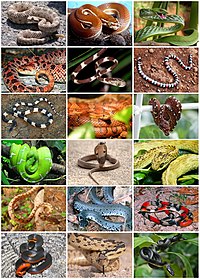
Photo from wikipedia
BACKGROUND The examination of the efficacy of near-infrared imaging using indocyanine green in laparoscopic lateral pelvic lymph node dissection remains insufficient. OBJECTIVE The aim of this study was to examine… Click to show full abstract
BACKGROUND The examination of the efficacy of near-infrared imaging using indocyanine green in laparoscopic lateral pelvic lymph node dissection remains insufficient. OBJECTIVE The aim of this study was to examine whether near-infrared imaging contributed to an increase in the total number of harvested lateral pelvic lymph nodes in laparoscopic lateral pelvic lymph node dissection. DESIGN This was a retrospective, multi-institutional study with propensity score matching. SETTINGS We conducted this study within the framework of the Yokohama Clinical Oncology Group in Japan. PATIENTS The study population included consecutive patients with middle-low rectal cancer (clinical stage II to III) who underwent laparoscopic lateral pelvic lymph node dissection between January 2013 and February 2018. MAIN OUTCOMES MEASURES The total number of harvested lateral pelvic lymph nodes was compared in laparoscopic lateral pelvic lymph node dissection with and without near-infrared imaging. RESULTS A total of 172 eligible patients were included; 84 of these patients underwent laparoscopic surgery with near-infrared imaging. After propensity score matching, 58 patients were matched in each of the Near-infrared and the Non-near-infrared groups. The operation time in the Near-infrared group was significantly longer than that in the Non-near-infrared group (426 vs. 369 min), and the amount of intraoperative blood loss in the Near-infrared group was significantly smaller than that in the Non-near-infrared group (13 vs. 110 ml). The total number of harvested lateral pelvic lymph nodes in the Near-infrared group was significantly higher than that in the Non-near-infrared group (14 vs. 9). There were no significant differences in the postoperative complication rates of the two groups. LIMITATIONS The limitations of the present study include its retrospective design. CONCLUSIONS This study revealed that laparoscopic lateral pelvic lymph node dissection combined with near-infrared imaging could increase the total number of harvested lateral pelvic lymph nodes without impairing functional preservation. See Video Abstract at http://links.lww.com/DCR/B800.This study was registered with the Japanese Clinical Trials Registry as UMIN000041372 (http://www.umin.ac.jp/ctr/index.htm).
Journal Title: Diseases of the colon and rectum
Year Published: 2021
Link to full text (if available)
Share on Social Media: Sign Up to like & get
recommendations!